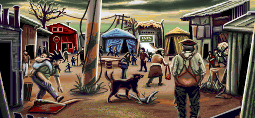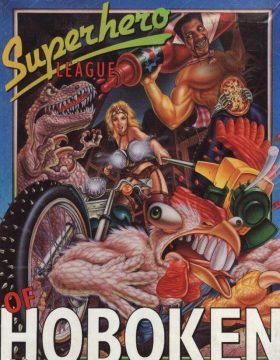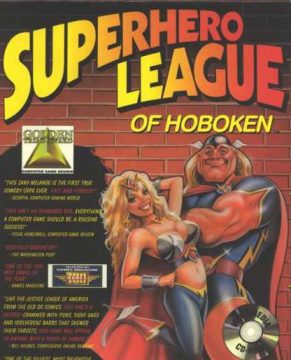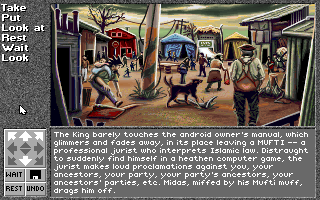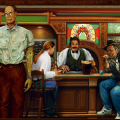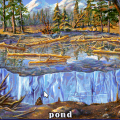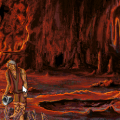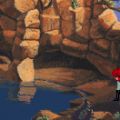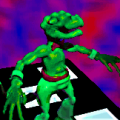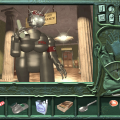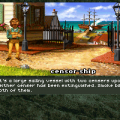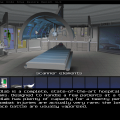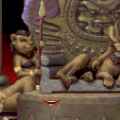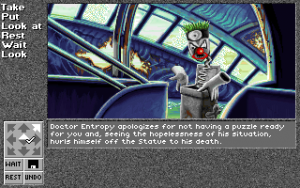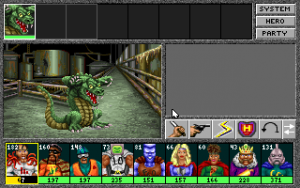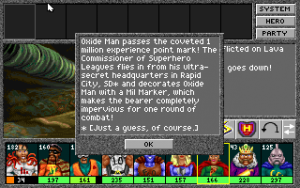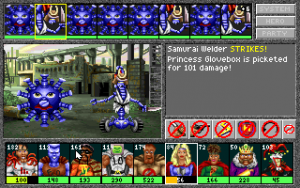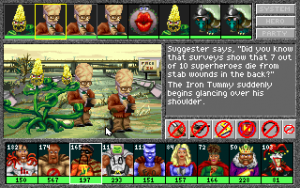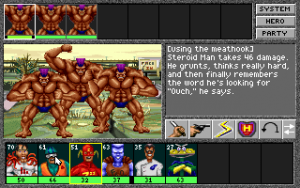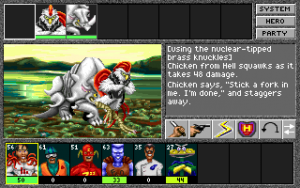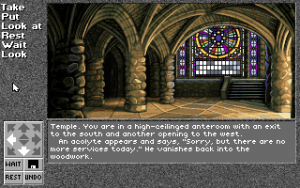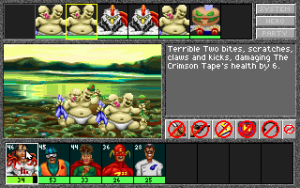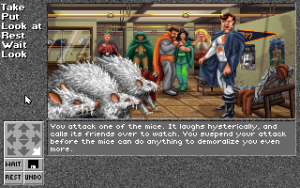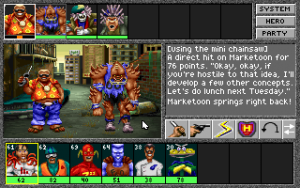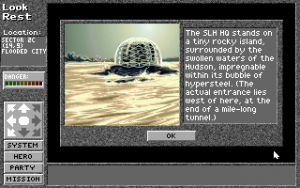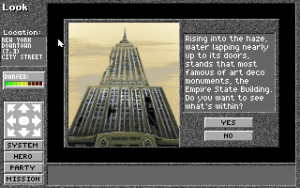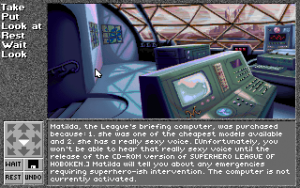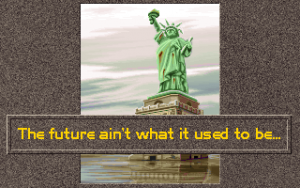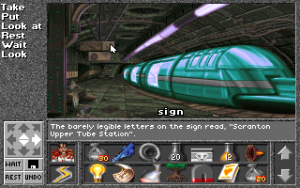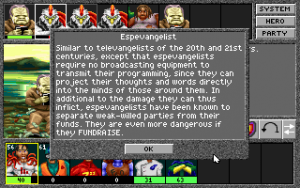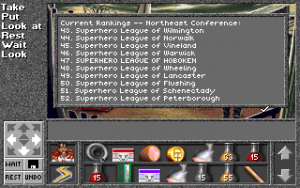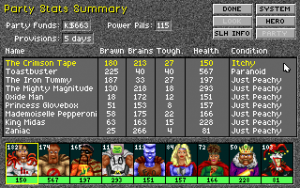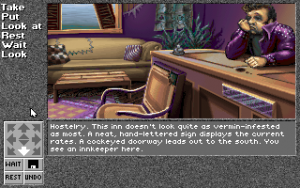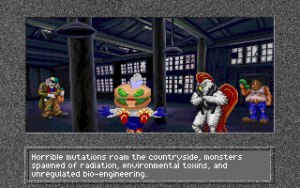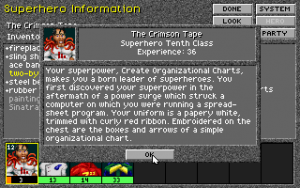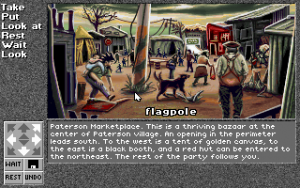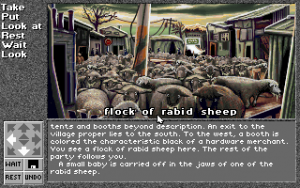There have been many memorable humorous adventure games, but considerably less common is the humorous RPG. Superhero League of Hoboken thus distinguishes itself immediately as not only an RPG-adventure hybrid, but a thoroughly amusing one at that. Furthermore, rather than take the easy way out and poke fun at the same old fantasy tropes (see Kyrandia, Companions of Xanth, and Simon the Sorcerer), Superhero League of Hoboken is actually set in the vastly amusing world of post-apocalyptic New Jersey.
You wouldn’t think that America would be a very funny place after the fall of civilization, what with the populace devastated by nuclear fallout and flooding from the polar ice caps. As presented in Superhero League of Hoboken, it is a land dominated by crazed warlords and fanatic religious cults, and should you fall prey to one of the many hideous mutations on the prowl, the only medical assistance you’re likely to find is a maniacal chanting witch doctor.
It turns out things are not all that bad, however. You could hardly expect them to be – unlike many contemporary Legend properties, this is a game with an original story by the great Steve Meretzky, the industry veteran responsible not only for many of Legend’s hilarious adventure games, including the Spellcasting series, but also for many of the classic Infocom text adventures that preceded them. Thus, the remnants of civilization are not overcome by despair, for they find protection in the form of the Superhero Leagues, including the titular Superhero League of Hoboken.
Hoboken is a real city in New Jersey, located across the Hudson River from New York City. The game’s starting location of the League’s headquarters is fortunately located above a Hoboken museum, presenting it as the birthplace of Frank Sinatra and the location of the first American brewery, among other things. You’re assigned the role of the Crimson Tape, who has become leader of the League when it has fallen on hard times. His superpower allows him to create organizational charts out of thin air, an ability that serves no purpose whatsoever. Given that he is also a silent protagonist, he is probably the least interesting character in the game, but you’re stuck with him for the whole time.
You’ll soon discover Matilda, the League’s Mission Computer, a surprisingly functional and personality-free appliance. At any given time, Matilda will have information on five different crises occurring in the area that demand your attention, including information on how to get to the location of each one. These missions can be accomplished in any order, except for one, which will inevitably pit the Superhero League of Hoboken against the notorious Dr. Entropy, a psychotic, brilliant Jack-in-the-Box constantly plotting some nefarious scheme to spread misery and terror. Dr. Entropy usually has some form of security that can only be defeated by using four objects, each of which can only be obtained by completing the other four missions. Defeat Dr. Entropy, and you’ll be assigned a new set of missions and attract more superheroes to the League.
One of the first things you’ll do in the headquarters is assemble a team of superheroes from among those gathered in the cafeteria. You’ll never actually see anything more of them than what you can see in their portraits, and with one possible exception, none of them undergo any kind of character development. Still, they each have their own little paragraph of background information and two unique dialog blurbs should you choose to talk to them. If nothing else, they’re a fairly original bunch and you cannot easily call any of them a knockoff of something from DC or Marvel.
With your party assembled, you’ll depart headquarters and be presented with a top-down view of the unexplored overworld, which you’ll need to traverse in order to get to the various locations where your mission objectives lay. In the process, you’ll inevitably experience random encounters with groups of enemies. Generally in such encounters the two or three heroes at the front of your party will exchange melee damage with two or three enemies at a time, while the other members of your party will attack with projectile weapons.
Some of your party members might be able to use their superpowers in combat. These powers, like projectile weapons, target individual enemies, and basically amount to magic spells – they’re extremely effective against some enemies, and completely useless against others. It’s usually pretty obvious which powers will affect a particular enemy, even though the powers take much more interesting forms than the usual fire/ice/lightning elemental stuff so common in RPGs. Tropical Oil Man, for example, can “Raise Foe’s Cholesterol”, effective against humanoids (and animals, to some extent). Conversely, Captain Excitement can “Put Animals To Sleep”, an effective power against animals (and not so much humanoids).
Your party members can gain additional superpowers through the use of isotopes found throughout the game, though it takes multiple doses for these secondary powers to become as effective as their starting powers. Again, like magic spells, some party members are better-suited for wielding powers than others by virtue of their high “Brain” stats. Other members with a lower “Brain” stat are best kept at the front of the party to deal melee damage, as they tend to have higher “Brawn” stats. There are quite a few other stat-boosting items around to allow you to further customize your party, should you choose to do so.
All you need to worry about in battle is your party’s hit points – superpowers can be used as many times as you want with no penalty. There is also a complete lack of healing powers or healing items that can be used in combat; the only way to heal your party is to get to a location where you can Rest. (Naturally, you can only Rest a certain number of times before you need to go back to HQ or pay money at a hostelry.)
Despite its simplicity, combat is just lively enough to keep things interesting. There’s the occasional enemy that can fire projectiles, induce status ailments, or launch a devastating suicide attack that will have to be given special consideration. Disappointingly, although there are some unusually powerful enemies, there aren’t really any bosses to speak of – not even Dr. Entropy. The final combat of the game is just a big free-for-all featuring one of every enemy in the game, and it’s not even terribly difficult.
But by far the greatest saving grace of the combat is the writing. There’s a wonderfully varied selection of forty-one different baddies to thwart that almost rivals that of Earthbound (probably the only other humorous RPG you’re likely to encounter) as far as diversity goes. There are no palette swaps to be found here! Nor does the detail end merely with the well-drawn looping animations. Rather than something simple along the lines of “the foozle strikes for 10 damage”, the precise combat techniques employed by your enemies tend to be described in hilarious depth, as are their reactions as they take damage from your party. The CD-ROM version even includes voice samples for many of them. Of course, if you’re in a hurry you can easily just click through everything without having to read it, but there’s just enough text for each enemy and just enough enemies to make you slow down a bit.
Enemies are pretty much what you’d expect in a devastated future – technological conveniences run amok, vicious biological mutations, and lawyers. One of the coolest enemies is probably the Espevangelist – an advanced form of a religious televangelist capable of projecting his thoughts directly into other people’s minds. Dealing damage to him often brings up descriptions of your party members revealing dirty secrets about their personal life.
Your movements on the world map are principally restricted first by the massive floodwaters, which can either be overcome by having enough members of your party who have the “Really Good At Treading Water” superpower, or by purchasing a particular item later in the game. Once water is no longer a problem, you’ll still be prevented from wandering everywhere by a lack of Tube Car passes, used on an experimental high-speed mass-transit system described as having been built during the Gore administration. These restrictions easily prevent you from wandering into an area where enemies are too powerful or from wasting too much time at locations where there’s nothing to be found at a particular stage in the game, but there’s still a good amount of exploring to do at any given time if the adventure game component gets you down.
Like pretty much any RPG, you’ll encounter towns equipped with the usual shops, as well as the aforementioned hostelries. Somewhat atypical are the brothels, which basically serve as an amusing way of trading money for experience points. There’s occasionally some mission-related adventuring business required at any given town, and pawn shops also often hoard vital items. Every single item is unique, so you’ll never have more than one of any particular item. The game consequently has some really inventive names for weapons and armor – you can outfit a character with an iron thimble, gore-tex hot pants, a vomitproof vest, and a concrete mortarboard, while having him fend enemies off with arsenic-tipped deer antlers and a bowel disruptor. In fact, every character can equip two weapons and a whopping ten pieces of armor (each for a different body part), without any other restrictions.
One of the game’s annoyances is that there is very little to distinguish one town from another, especially after you’ve bought everything that’s for sale. There are also no names to be found on any of the maps that the game makes available. Nonetheless, you will occasionally be directed to go to, say, Yonkers or Staten Island, with no further indication of where these places are located other than some occasional vague clues.
Apart from towns are the many other locations you’ll visit over the course of your missions, most of which only take up a screen or two. Many of them are based on actual landmarks ravaged by the fall of civilization – Dodger Stadium, the Empire State Building, the Statue of Liberty, and so on. There are plenty of parts of suburban New Jersey too, including Paterson, East Orange, Morristown and Hackensack, as well as parts of New York (Poughkeepsie) and Pennsylvania (Scranton). These locations are presented through an interface that looks exactly like Legend’s other adventure games, with the usual first-person point of view and serviceable VGA graphics with largely nonexistent animation. There’s a good number of NPCs to talk to, and the CD-ROM version provides fully voiced dialog.
Some missions require you to bring a superhero with a particular power to a particular location. For example, the Iron Tummy, with his ability to eat spicy foods without distress, is a natural choice to bring with you when you go on a mission to Newark, where a warehouse filled with dangerously spicy bio-engineered jalapeno peppers threatens to contaminate the local water supply. However, as that’s the only spicy food you’re going to encounter for the entire game, the Iron Tummy’s power is completely useless afterward. (There are a surprising number of missions where you might think the aforementioned “Put Animals To Sleep” power would be entirely appropriate, but the game stubbornly refuses to ever let you use it outside of combat.)
While there are a couple of fetch-quest missions, most of the other missions do involve at least a little typical adventure-game puzzle solving. Thanks to Legend’s interface, most of these puzzles aren’t terribly difficult – every verb you can apply to an object (except for superpowers) pops up as soon as you click on it, practically spelling out the solution to whatever problem you’re facing. The only catch is that it is absolutely essential that you pick up everything you can in every location. If you don’t, you can be in for a real headache, as there are just so many different places you can visit, and even when the random encounters have been taken care of, backtracking is very time-consuming.
As with the combat, the whole experience is made more than bearable by the hilarious writing. There are a few bits that are definitely a bit dated; the references to former Yankees owner George Steinbrenner reek of the ‘90s, so Dr. Entropy’s plan to revive his cryogenically-preserved body and have him wreak havoc upon the land falls a bit flat. By and large, though, it’s timeless stuff, albeit hard to pin down stylistically. There’s no shortage of images showing decay and ruin, but the game doesn’t really wallow in it or descend into black comedy. At times there is some vague commentary about the excesses of present-day society, but the game never gets preachy either. Some elements seem to verge on total absurdity – what is a guacamole factory doing in a devastated landscape, and how could its workers afford to strike? – but the realistic quality of the graphics makes it all too easy to take everything in stride. There are a few jokes based on the idea of a future civilization being unable to comprehend the meaning or functionality of some present-day artifacts, but not so many that it gets old. In the end, it’s just good solid writing of the sort you’d expect from an experienced interactive fiction author.
Steve Meretzky reportedly set out to create a game whose RPG components would not intimidate adventure gamers, and whose adventure game components would not prove to be an obstacle to those who preferred RPGs. While he succeeded, the whole thing might have ended up being largely forgettable if not for the stellar quality of the writing. As it is, it might just be the funniest RPG you’ll ever play.
